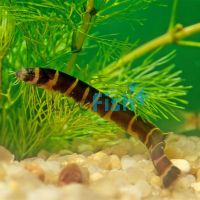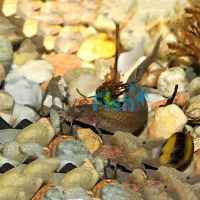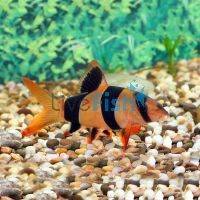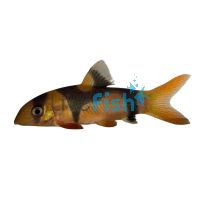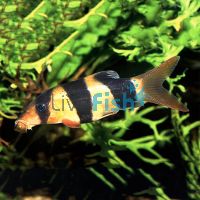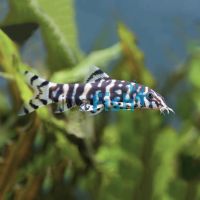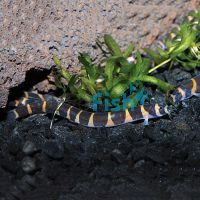These are a great species for those looking to add some character to their tanks and are particularly useful for clearing up any errant snail populations in your aquarium. Although they are great fish for community aquariums, be aware of Clown loaches in particular as they may reach sizes of up to 25 cm, so be sure you have a freshwater aquarium that can house a fish this size.
Loach Care
Loaches are a wonderfully hardy fish that can handle a range of water conditions. However, you should be sure that your aquarium is very well cycled and all nitrate and ammonia spikes are minimalised before introducing loaches as they are fairly susceptible to these. For the most part, they are friendly and low maintenance fish that enjoy hanging out with their own kind. If properly cared for they have very long lifespans and feature very strong characteristics, sometimes to the point they will appear to interact with their aquarist. This is especially true for our most popular species the Clown loach, though you may also consider the more bashful Kuhli loach or the more curious Pakistani reticulate loach.
Natural Habitat
Most species of loach are found in central and southern Asia, though a couple of species have been found in Europe and Africa. In the wild, they typically prefer slightly faster moving water but will be just as happy in just mildly moving waters.

Behavior/Compatibility for Loaches
Loaches’ behaviour varies quite dramatically between species, however, they are all bottom-dwelling fish and are all happiest in groups. Clown loaches are very confident and playful fish that enjoy interacting with other fish and their owners and have even been known to play with certain shells or pieces of substrate. They have a genial temperament and will get along well with just about every similarly well-behaved fish species. Pairing clown loaches with aggressive species is not advised as the clown loach will not stand up for itself and may retreat to cover almost permanently. Kuhli loaches tend to be much shier compared to clown loaches and will spend all their time hidden away if they feel even slightly uncomfortable. They do best in aquariums featuring similarly shy fish such as Tetras, Rasboras and Corydoras. Pakistani reticulate loach or Yo-yo loaches can be semi-aggressive at times, but this also means they are capable of defending themselves a bit more effectively than Clown loaches. These fish should be kept in groups of at least 4 to try to mitigate aggression among the school. It should also be noted that while loaches are great for keeping unwanted snails out of your aquarium, they will of course be unsuitable if you are actively trying to keep snails.
Housing Loaches and Aquarium Fish Tank Set-up Tips
Tank
Tank size will depend massively on the type of loach you are interested in keeping. Although Clown loaches may appear to stay at a very manageable size for a long time, these fish may live for years or even decades and eventually reach nearly a foot in length. Dwarf loaches on the other hand will only manage to grow up to about 6 cm (2.5”), so obviously, their needs will be very different. In the following table we will be focusing on the mid-size loaches such as Pakistani reticulate or Yoyo loach, but be aware that if you are interested in Clown loaches you will need a tank size of at least 280 litres (75 gallons) for one, and 560 litres (150 gallons) to house the recommended group size of 5 Clown loaches. Long tanks are far better for loaches than tall tanks.
Recommended Max Fish Count Tank Volume 4 Loaches 94 litres (25 gallons) 6 Loaches 113 litres (30 gallons) 8 Loaches 132 litres (35 gallons) 10 Loaches 150 litres (40 gallons) Base
Loaches prefer soft sand or fine gravel substrate in which they can root around for scraps without injuring themselves.
Foliage
Tougher plants such as Anubias are recommended for clown loaches as they have a habit of tearing plants just for the fun of it. Surface floating plants are a good idea for Kuhli loaches as they may encourage the Kuhli to approach the surface to eat any microorganisms growing on the plants. All Kuhlis require caves and overhangs in which to take shelter and sleep. Driftwood is a great option for Clown loaches as they enjoy taking shelter in groups beneath it. Note they may sleep on their sides and appear dead, but this is just another strange quirk of the species. For Pakistani reticulate loaches, be sure that any aquarium supplies and decorations you select have holes large enough for the entire school as they have been known to get themselves stuck in gaps.
Water
As loaches hail from subtropical climates, they tend to enjoy temperatures of around 15 to 25 degrees C (59 - 78 F), though they can handle temperatures beyond these limits. Depending on your local climate, you may need to install a water heater to ensure the temperature stays within this range.
You should aim for a Ph of 6-8 and a hardness of 5-15 DGH. To ensure your pH and hardness are suitable you should invest in a testing kit. A slow to moderate water flow suits them well, and the water should be aerated with a fish tank air pump.
Always ensure your water is properly filtered, and regularly change the water (10% weekly or 25% every other week). You should also filter the substrate regularly and adjust the chemistry of any tap water you use to top your tank. You may do this with one of our many water conditioning products.
Feeding and Care
While loaches will eat waste, scraps, algae and naturally occurring micro-organisms, they will also require a diet of both meat and plant material. As bottom feeders, they prefer sinking pellets and particularly enjoy frozen bloodworms. Brine shrimp and daphnia are also commonly used. You should also feed them the occasional cucumber slice to ensure they get their plant nutrients. Please see our wide selection of fish food options to find something suitable for your loaches.
Great reasons to keep Loaches in your tropical fish tank
- • They can offer a great personality and interaction with you.
- • They can control any errant snail outbreaks in your tank for you.
- • They play well with others and will very rarely cause any problems in a community tank.
Check out our loach varieties below to find your new fish pets. Select a species most fitting for your fish tank setup, if you can't decide then why not go for one of our loach packages and then wait for your fish to be delivered right to your door!
